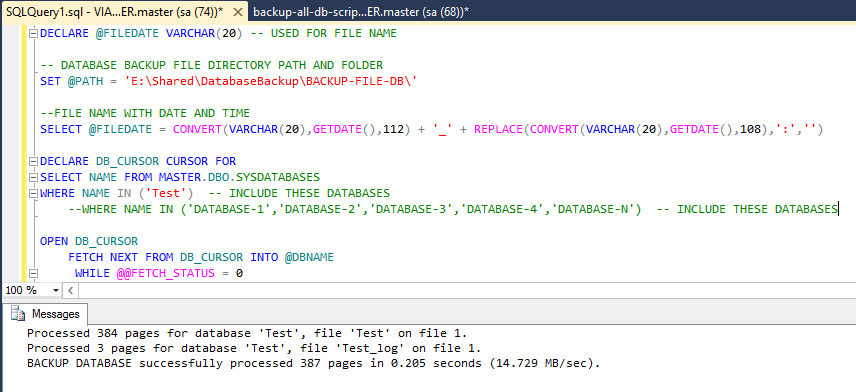The below query sql server backup single “Test” databases
For Multiple databases backup query looks like
The output for single database backup looks like,
DECLARE @DBNAME VARCHAR(50) -- DATABASE NAME DECLARE @PATH VARCHAR(256) -- BACKUP FILES PATH DECLARE @FILENAME VARCHAR(256) -- FILENAME FOR BACKUP DECLARE @FILEDATE VARCHAR(20) -- USED FOR FILE NAME -- DATABASE BACKUP FILE DIRECTORY PATH AND FOLDER SET @PATH = 'E:\Shared\DatabaseBackup\BACKUP-FILE-DB\' --FILE NAME WITH DATE AND TIME SELECT @FILEDATE = CONVERT(VARCHAR(20),GETDATE(),112) + '_' + REPLACE(CONVERT(VARCHAR(20),GETDATE(),108),':','') DECLARE DB_CURSOR CURSOR FOR SELECT NAME FROM MASTER.DBO.SYSDATABASES WHERE NAME IN ('Test') -- INCLUDE THESE DATABASES --WHERE NAME IN ('DATABASE-1','DATABASE-2','DATABASE-3','DATABASE-4','DATABASE-N') -- INCLUDE THESE DATABASES OPEN DB_CURSOR FETCH NEXT FROM DB_CURSOR INTO @DBNAME WHILE @@FETCH_STATUS = 0 BEGIN SET @FILENAME = @PATH + @DBNAME + '_' + @FILEDATE + '.BAK' BACKUP DATABASE @DBNAME TO DISK = @FILENAME FETCH NEXT FROM DB_CURSOR INTO @DBNAME END CLOSE DB_CURSOR DEALLOCATE DB_CURSOR
For Multiple databases backup query looks like
DECLARE @DBNAME VARCHAR(50) -- DATABASE NAME DECLARE @PATH VARCHAR(256) -- BACKUP FILES PATH DECLARE @FILENAME VARCHAR(256) -- FILENAME FOR BACKUP DECLARE @FILEDATE VARCHAR(20) -- USED FOR FILE NAME -- DATABASE BACKUP FILE DIRECTORY PATH AND FOLDER SET @PATH = 'E:\Shared\DatabaseBackup\BACKUP-FILE-DB\' --FILE NAME WITH DATE AND TIME SELECT @FILEDATE = CONVERT(VARCHAR(20),GETDATE(),112) + '_' + REPLACE(CONVERT(VARCHAR(20),GETDATE(),108),':','') DECLARE DB_CURSOR CURSOR FOR SELECT NAME FROM MASTER.DBO.SYSDATABASES WHERE NAME IN ('DATABASE-1','DATABASE-2','DATABASE-3','DATABASE-4','DATABASE-N') -- INCLUDE THESE DATABASES OPEN DB_CURSOR FETCH NEXT FROM DB_CURSOR INTO @DBNAME WHILE @@FETCH_STATUS = 0 BEGIN SET @FILENAME = @PATH + @DBNAME + '_' + @FILEDATE + '.BAK' BACKUP DATABASE @DBNAME TO DISK = @FILENAME FETCH NEXT FROM DB_CURSOR INTO @DBNAME END CLOSE DB_CURSOR DEALLOCATE DB_CURSOR
The output for single database backup looks like,
